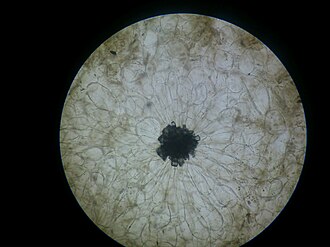Sclereid
Sclereids are a type of plant cell known for their thick, lignified walls, which contribute to the hardness and stiffness of plant tissues. They are a specialized form of sclerenchyma cells, which serve the primary function of providing mechanical support and protection to various parts of the plant. Unlike their counterpart, the fibres, sclereids are more variable in shape and often shorter. They are found in many different parts of plants, including the seed, fruit, stem, and leaves.
Types of Sclereids
Sclereids can be classified into several types based on their shape and location within the plant:
- Brachysclereids, or stone cells, are roughly isodiametric and can be found in the pear flesh, giving it a gritty texture.
- Astrosclereids are star-shaped and are commonly found in the leaves of certain plants, contributing to their stiffness.
- Osteosclereids resemble bone in shape and are often located in the layers around the vascular bundles.
- Fibrosclereids are elongated and can be found in the xylem or the hard shells of nuts.
- Trichosclereids, or hair-like sclereids, extend into the intercellular spaces of the plant tissue.
Function
The primary function of sclereids is to provide mechanical support and protection. Their hard, lignified walls help to reinforce the plant's structure, making it resistant to external pressures and damage. In addition, sclereids can also play a role in deterring herbivory by making the plant tissues harder to consume or by damaging the digestive systems of herbivores.
Distribution
Sclereids are distributed throughout various parts of the plant. Their presence in the seed coats helps protect the embryo during development and dispersal. In fruits, such as pears, sclereids contribute to the texture. In leaves and stems, they help maintain the plant's rigidity, allowing it to stand upright and resist bending or breaking under its own weight or external forces.
Development
Sclereids develop from parenchyma cells that undergo a secondary thickening process, where additional layers of cell wall material, primarily lignin, are deposited. This process is regulated by the plant's genetic makeup and environmental factors, which can influence the density, distribution, and morphology of sclereids.
Ecological and Economic Importance
Sclereids play a significant role in the ecology of plants by providing structural support and protection against herbivores and environmental stresses. Their presence in fruits and seeds affects the dispersal and germination strategies of plants, influencing ecological interactions and biodiversity. Economically, sclereids impact the texture and quality of certain fruits and vegetables, which can affect consumer preferences and market value.
Transform your life with W8MD's budget GLP-1 injections from $125.
W8MD offers a medical weight loss program to lose weight in Philadelphia. Our physician-supervised medical weight loss provides:
- Most insurances accepted or discounted self-pay rates. We will obtain insurance prior authorizations if needed.
- Generic GLP1 weight loss injections from $125 for the starting dose.
- Also offer prescription weight loss medications including Phentermine, Qsymia, Diethylpropion, Contrave etc.
NYC weight loss doctor appointments
Start your NYC weight loss journey today at our NYC medical weight loss and Philadelphia medical weight loss clinics.
- Call 718-946-5500 to lose weight in NYC or for medical weight loss in Philadelphia 215-676-2334.
- Tags:NYC medical weight loss, Philadelphia lose weight Zepbound NYC, Budget GLP1 weight loss injections, Wegovy Philadelphia, Wegovy NYC, Philadelphia medical weight loss, Brookly weight loss and Wegovy NYC
|
WikiMD's Wellness Encyclopedia |
| Let Food Be Thy Medicine Medicine Thy Food - Hippocrates |
Medical Disclaimer: WikiMD is not a substitute for professional medical advice. The information on WikiMD is provided as an information resource only, may be incorrect, outdated or misleading, and is not to be used or relied on for any diagnostic or treatment purposes. Please consult your health care provider before making any healthcare decisions or for guidance about a specific medical condition. WikiMD expressly disclaims responsibility, and shall have no liability, for any damages, loss, injury, or liability whatsoever suffered as a result of your reliance on the information contained in this site. By visiting this site you agree to the foregoing terms and conditions, which may from time to time be changed or supplemented by WikiMD. If you do not agree to the foregoing terms and conditions, you should not enter or use this site. See full disclaimer.
Credits:Most images are courtesy of Wikimedia commons, and templates, categories Wikipedia, licensed under CC BY SA or similar.
Contributors: Prab R. Tumpati, MD


